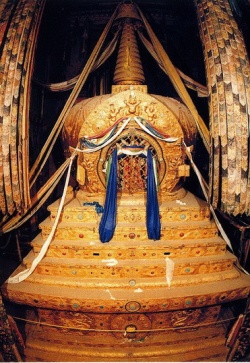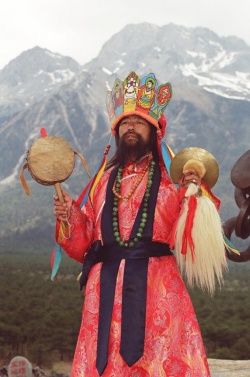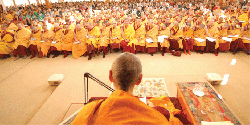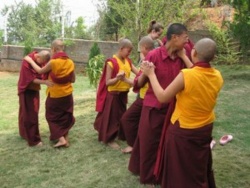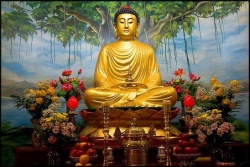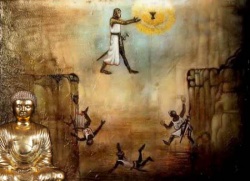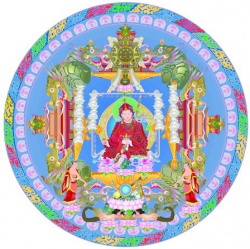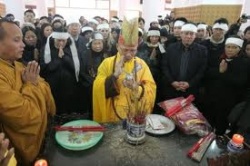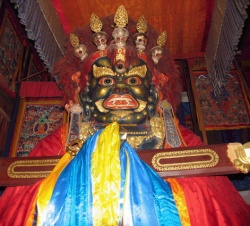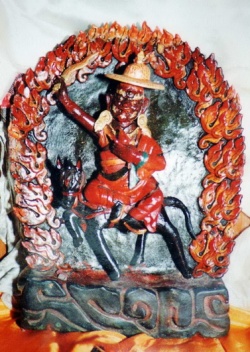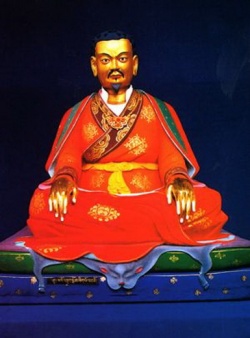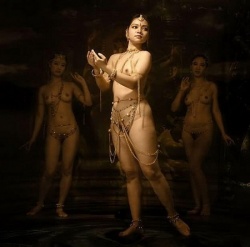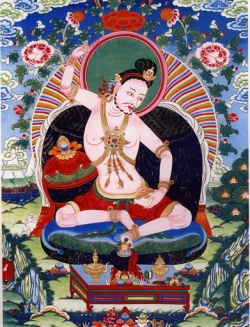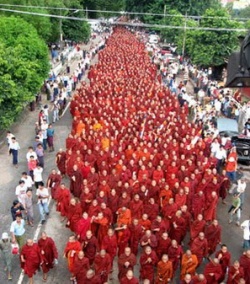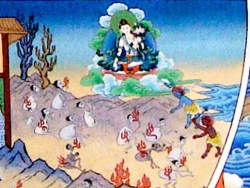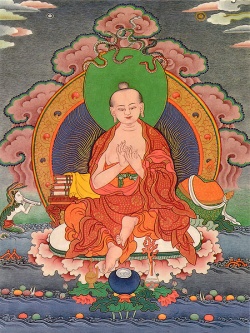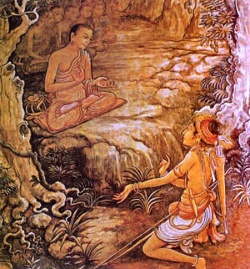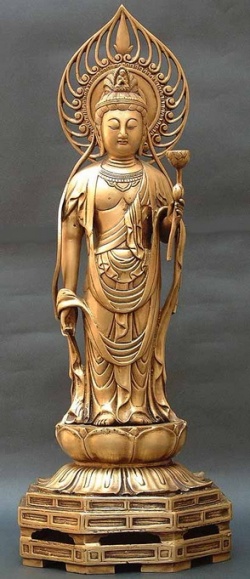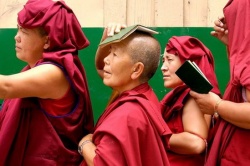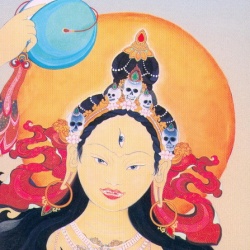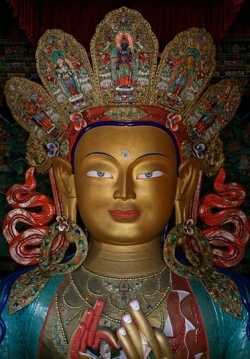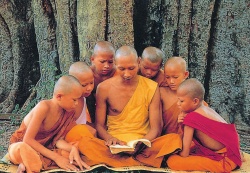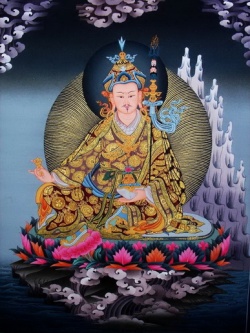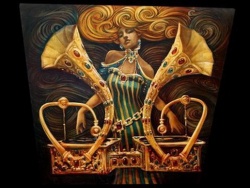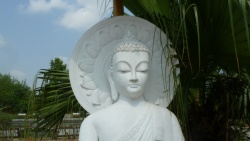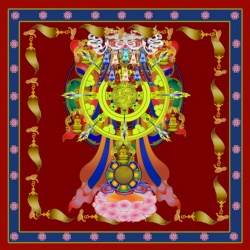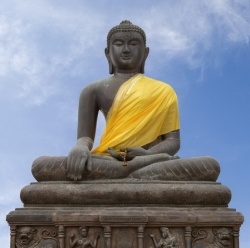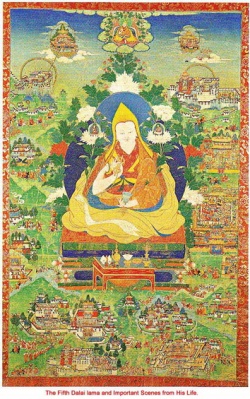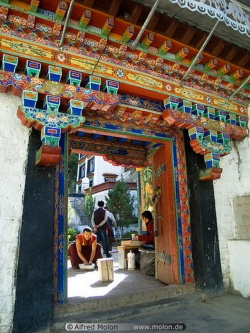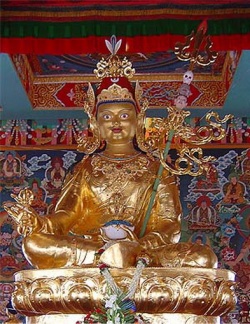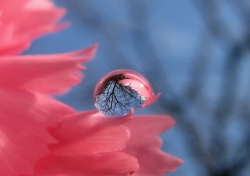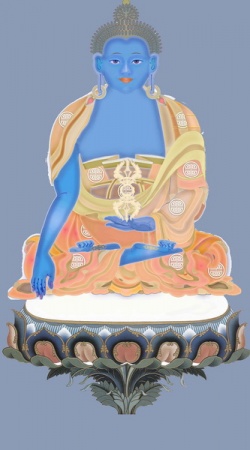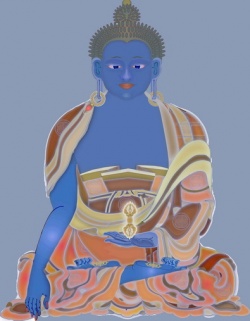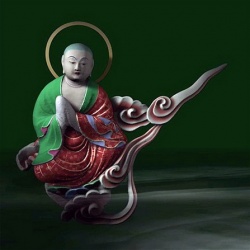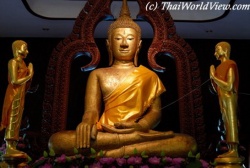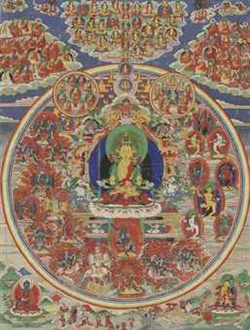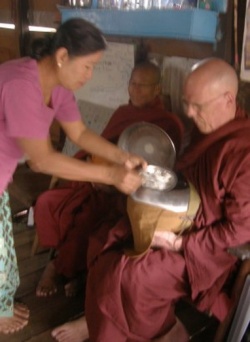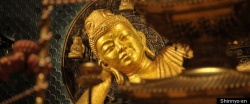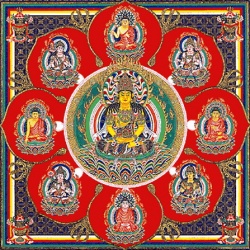The Hidden or Implied Meaning of Chinese Charm Symbols
Differences between Chinese Coins and Chinese Charms
Most old Chinese coins have an inscription of four Chinese characters to identify the historical time of their casting and their monetary value.
Most Chinese charms also have four (or more) Chinese character inscriptions but the inscription is not meant to identify when the charm was made or its monetary value (which is none). Instead, the inscription is either an auspicious desire, such as for good luck, good fortune, good health, success in the imperial examinations or business, etc., or a wish to avert misfortune from evil ghosts and spirits.
(For additional information on Chinese charm inscriptions, please see Guide to Reading Chinese Characters (Symbols) on Charms and English Translation of Chinese Charm Inscriptions.)
More importantly, and unlike Chinese coins, most Chinese charms also depict a variety of objects meant to enhance the inscriptions with rich symbolic meanings.
Visual and Spoken Puns
One of the peculiarities of the Chinese language is that it has a very large number of written characters but a much smaller number of spoken sounds. As a result, many Chinese characters share the same pronunciation, i.e. are homonyms.
The charms of the Ming (1368 - 1644 AD) and Qing (Ch'ing) (1644 - 1911 AD) dynasties, in particular, frequently took advantage of this characteristic. The charms may use depictions of animals, plants and other objects to substitute for other words because of their
similarity in pronunciation, even though they may not have any other relationship to what is being expressed. This is what I mean by a hidden or implied meaning or visual pun, and what the Chinese refer to as auspicious or lucky pictures (jixiangtuan 吉祥图 案). A more technical term would be a rebus.
Chinese Symbols and Their Meanings
Since a fundamental difference between old Chinese coins and charms has to do with the use of symbols, a basic understanding of the language of the symbols is needed to fully appreciate Chinese charms. Listed below, in alphabetical order, is a comprehensive list of objects that include those which have become symbols because of their similar pronunciation to auspicious Chinese words. Also included are other objects frequently seen on charms which have become symbols due to mythology, history or cultural associations.
| Apple |
An apple can be a visual pun for peace because the Chinese word for apple (pingguo 苹果) and the word for peace ( pingan 平安) are both pronounced ping. A persimmon (shi 柿) paired with an apple (pingguo 苹果) forms the rebus "may your matters (shi 事) be safe ( pingan 平安)". |
| Apricot |
An apricot grove, or field of apricots, is a symbol for success in the imperial examination system because the very first celebration honoring successful candidates allegedly took place in an apricot grove. |
| Axe (axe head) |
The axe (fu 斧) has the same pronunciation as "happiness" (fu 福) and as a weapon symbolizes power and the ability to punish. The axe head is also one of the Twelve Imperial Symbols. |
| Bamboo |
Bamboo symbolizes the ideals of a Confucian scholar because both are perceived as upright, strong and resilient while still being gentle, graceful and refined.
|
| Bat |
A picture of a bat (fu 蝠) can be a visual pun for "good fortune" or happiness (fu 福) because both characters are pronounced fu. Often the bat is shown flying upside down because the character (dao 倒) for "upside-down" and the character (dao 到) meaning "to have arrived" are both pronounced dao. Therefore, if a person were to say "the bat is flying upside down" a listener could just as easily hear this as "happiness has arrived" which, of course, has a very auspicious connotation. (View charms with"upside down" bat and eight treasures, Zhong Kui, Zhong Kui, Liu Hai, and deer.)
Bats live in caves which represent portals to the beyond. |
| Bear |
The bear (xiong 熊) is not often depicted on Chinese charms and amulets but it is a powerful animal that the Chinese believe can invoke fear in evil spirits just as well as humans. However, the bear is sometimes shown with an eagle because eagle or hawk (ying 鹰) and bear (xiong 熊) together sound just like the word "hero" (yingxiong 英雄). |
| Boar |
See entry for pig below.
|
| Bran |
Bran (wheat bran) is an auspicious fertility symbol at marriages because its pronunciation (fu zi 麸子) sounds the same as "rich son" (fu zi 富子) thus representing the wish that the couple will produce children who will become wealthy. |
| Buddha's Hand |
See entry for citron below. |
| Butterfly
|
The butterfly is a symbol of long life because the second character in butterfly (hudie 蝴蝶) has exactly the same pronounciation as the character 耋 (die) which means "70 or 80 years of age". |
| Cabbage
|
The cabbage (baicai 白菜 or qingcai 清菜) is a symbol for wealth because it has the same pronunciation as the word "money" or "wealth" (cai 财). |
| Calamus (Sweet Flag)
|
Calamus (chang pu 菖蒲), also known as "sweet flag", is a plant with long and stiff leaves which resemble swords. Since swords provide protection, hanging calamus above gates and doors is believed to help protect from evil spirits, disease and misfortune. |
| Carp
|
The carp fish is a commonly seen visual pun because the Chinese character for carp (li 鲤) is pronounced the same as both the character (li 利) for "profit" and the character (li 力) for "strength" or "power". The carp is also a symbol for an abundance of children because it produces many eggs.
|
| Cassia (Cinnamon) |
The cassia is an evergreen plant with bright yellow flowers that is sometimes incorrectly referred to as Chinese cinnamon.
See also "Cassia and Orchid" Charm.
|
| Castanets |
A symbol that resembles an "X" is sometimes found on Chinese charms. This is actually a pair of wooden clappers or castanets crossed one over the other.
|
| Cat |
The cat (mao 猫) symbolizes wishes for a long life because it has the same pronunciation as the word for an 80 year old or "octogenarian" (mao 耄).
|
| Chestnut
|
The Chinese word for chestnut (lizi 栗子) sounds exactly like saying "establishing" (li 立) "sons" or "children" (zi 子) and therefore is a good luck symbol for creating a family. The Chinese refer to the eight-sided holes found on many Tang and Song Dynasty coins as flower or chestnut holes.
|
| Chopsticks | Chopsticks (kuai zi 筷子) symbolize the hope for newlyweds to have children quickly because the pronunciation is the same as "fast" (kuai 快) "sons" (zi 子). (See Chinese Marriage.) |
| Chime Stone
|
The chime stone (qing 磬) was a percussion musical instrument in ancient China. Each chime stone was flat and shaped similar to a chevron. A small hole at the top center allowed the stone to be hung from a frame. The musical instrument consisted of a set of 8 to 24 of these chime stones with each tuned to a different pitch. When struck with a mallet the chime stone produced a musical sound. Since many chime stones were made of jade, the chime stone also symbolizes wealth and riches.
|
| Chrysanthemum
|
The chrysanthemum signifies the tenth month of the lunar calendar. The chrysanthemum, one of the Four Gentlemen, blooms late and in facing the winter symbolizes people who maintain their virtue despite adversity and temptation.
|
| Cicada
|
The cicada is a symbol of rebirth and immortality because after surviving underground for a long period of time it emerges and flies into the sky. |
| Citron or Buddha's Hand
|
The citron is a bright yellow lemon-like fruit with a thick rind and long finger-like tendrils. Because it resembles the familiar hand position of the Buddha, the citron has the auspicious Chinese name of foshou (佛手) which literally means "Buddha's Hand". The name foshou sounds very similar to the words fu (福 happiness) and shou (寿 longevity) and therefore the citron is a symbol for "happiness and longevity".
|
| Clouds
|
Clouds, sometimes referred to as "auspicious clouds" (xiangyun 祥云), represent the heavens and also "good luck" because the Chinese word for cloud (yun 云) is pronounced the same as yun (运) meaning "luck" or "fortune". Its form often resembles the auspicious shape of the lingzhi "fungus of immortality".
|
| Coin
|
Chinese coins are a potent symbol of wealth and prosperity. The coin is one of the "Eight Treasures".
|
| Coral
|
Coral (shanhu 珊瑚) is included as one of the Eight Treasures and symbolizes longevity and official promotion. As a symbol of longevity, the Chinese have traditionally believed that coral represents an "iron tree" (tieshu 铁树) that grew under the sea and blossomed only once every hundred years.
Red coral is considered particularly auspicious because the Chinese believe the color red signifies good luck, good fortune, and happiness. (See ribbons and fillets for more about the color red.) |
| Crab |
The Chinese word for crab (蟹) and the Chinese word for harmony (协) are both pronounced xie. The crab symbol is sometimes used on charms which express a desire for peace such as the large tian xia tai ping (天 下太平) charm shown at Peace Coins and Charms.
|
| Crane |
The crane (he 鹤) is believed by the Chinese to live to a very old age and therefore is a symbol of longevity. The crane's white feathers also represent old age.
(Nowadays, the "crane" is humorously referred to as the "national bird of China". In this case, however, the "crane" refers to the large machines used to lift heavy objects to the top of buildings as part of China's major construction boom!) |
| Cypress
|
Because the Chinese word for cypress (bai 柏) is pronounced the same as the word for "one hundred" (bai 百), the cypress is frequently paired with other symbols to express "many" or "everything". Cypress leaves were used in traditional Chinese weddings. |
| Date
|
The date fruit or Chinese jujube (zao 枣) conveys the meaning that something is going to happen soon because it has the same pronunciation as the word for "early" or "soon" (zao 早).
|
| Deer |
Deer are among the most frequently seen animals on charms. The Chinese character for deer is 鹿 which is pronounced lu. The Chinese character 禄, which refers to the salary a government official receives, is also pronounced lu. A picture of a deer is therefore expressing a wish for a top government office with a high salary.
The Chinese believe the deer lives to a very great age and, as a result, has become a symbol for long life.
|
| Dog |
The dog (gou 狗) is one of the twelve animals of the Chinese zodiac. |
| Door Gods |
The Door Gods are images of two warriors, Shen Tu and Yu Lei, which are hung on gates or doors to protect against evil spirits and misfortune.
|
| Dragon
|
The dragon (long 龙) is one of the twelve animals of the Chinese zodiac. The dragon is believed to live in the mountains or in the seas and can fly into the heavens.
Dragon charms with two dragons may be seen at: Open Work Charms and Auspicious Inscriptions. |
| Dragonfly
|
The dragonfly (qingting 蜻蜓) represents the Confucian ideal of pureness of character because its pronunciation is similar to the word for "pure" or "clear" (qing 清). The dragonfly also symbolizes the season of summer. |
| Ducks (Mandarin Ducks) |
Mandarin ducks (yuanyang 鸳鸯 or xi 鸂) are believed to mate for life and, therefore, a pair of mandarin ducks symbolize fidelity, conjugal affection, peace and prosperity. |
| Dumplings (jiaozi)
|
Chinese dumplings (with meat or vegetable stuffing) symbolize wealth or riches because they are boat-shaped and thus resemble the silver ingots or sycee used in ancient China as money. The word dumpling (jiaozi 饺子) has the same pronunciation as the first paper money (jiaozi 交子) used in China which was during the early Song Dynasty.
|
| Eagle (Hawk) |
The eagle or hawk (ying 鹰) symbolizes a "hero" (yingxiong 英雄) because the pronunciation is the same. See also entry for bear above. |
| Egret
|
See entry for heron below. |
| Eight (8) |
The number eight (ba 八) is the most auspicious number because its pronunciation, particularly in southern dialects, is very similar to "prosper" or "wealth" (fa cai 发财). |
| Eight Immortals |
The Eight Immortals (八仙) are eight daoists who have attained immortality and include: 1) Han Zhongli (汉钟离), also known as Zhongli Quan (锺离权), was a Han Dynasty general and is usually shown carrying a feather fan which he uses to revive the dead. |
| Eight Treasures |
The "Eight Treasures" (babao 八宝), also known as the "Eight Precious Things" and the "Eight Auspicious Treasures", may consist of eight ordinary symbols, the eight precious organs of the Buddha's body, the eight auspicious signs, or the various emblems of the eight Taoist Immortals. The most commonly seen members of the Eight Treasures include the coin, ruyi sceptre, coral, chime stone, lozenge, rhinoceros horn, silver ingot and the flaming pearl. In Buddhism, the Eight Treasures (Eight Auspicious Symbols) include the lotus (purity/enlightenment), Wheel of the Dharma (knowledge), treasure vase (wealth), conch shell (Buddha's thoughts), victory banner (Buddha's teachings conquer all), endless knot (harmony), parasol (protection) and fish pair (happiness in marriage). |
| Elephant |
The elephant is considered an auspicious animal because the Chinese character for "elephant" (xiang 象) has the same pronunciation as the Chinese word for "auspicious" or "lucky" (xiang 祥). The elephant is sometimes shown carrying a "treasure" vase (bao ping 宝瓶) on its back. Since the word "vase" (ping 瓶) has the same pronunciation as the word for "peace" (pingan 平 安), the implied meaning is "may you have 'good luck' (elephant) and 'peace' (vase)". |
| Fish |
The Chinese character for fish (yu 鱼) is pronounced the same as the Chinese character for "abundance" or "surplus" (yu 余). The fish symbol is, therefore, frequently associated with other symbols and Chinese characters to symbolize the wish for "more" in the sense of "more" good luck, good fortune, long life and children. (Please see images at Ancient Chinese Fish Charms and Chinese Open Work Charms.) As an example, to express the wish for "having more happiness year after year" a charm may use the Chinese character 年 (nian) for year, and also include a picture of a fish, a lotus and a magpie. The fish (yu 鱼) represents "more" (yu 余). The character 莲 for lotus and the character 连 meaning "in succession or one after another", as in expressing year after year, are both pronounced lian . The magpie (xi que 喜鹊) is pronounced the same as happiness . So the fish, lotus, magpie and the Chinese character 年 (year) together would have the implied meaning of "more" "happiness" "year after year". |
| Five Blessings (Happinesses, Good Fortunes) |
According to the ancient Chinese classic the "Book of History" (shujing 书经 or shangshu 尚书), also known as the "Classic of History", there are "Five Blessings" (wufu 五福), also known as the "Five Happinesses" or "Five Good Fortunes", which refer to longevity (shou 寿), wealth (fu 富), health and composure (kangning 康宁), virtue (xiu hao de 修好德), and the desire to die a natural death in old age (lao zhong ming 考 终命). Popular among the Chinese people is another set of "five blessings" which consists of good fortune (fu 福), government official salary (lu 禄), longevity (shou 寿), joy (xi 喜) and valuables or property (cai 财). |
| Five Poisons |
The five poisons (五毒), also known as the "Five Poisonous Creatures", refer to five poisonous animals which usually include the snake, scorpion, centipede, toad and spider. Sometimes, the lizard replaces the spider. |
| Fly Whisk |
The fly whisk is a simple tool used to swat or sweep away flies. The "fly whisk" became a symbol associated with certain Daoist (Taoist) immortals and Buddhist deities which was used to "sweep away" ignorance. |
| Four Blessings |
The "four blessings" (si fu 四福) are happiness (xi 喜), salary of a high official (lu 禄), longevity (shou 寿), and good luck (good fortune) (fu 福). |
| Four Divine Creatures |
The Four Divine Creatures, also known as the Four Heraldic Animals, Four Directional Animals, and Four Symbols (si xiang 四象), symbolize the four directions and an associated season as follows: Vermillion (Red) Bird (zhuque 朱雀) south and summer; White Tiger (baihu 白虎) west and autumn; Azure Dragon (qinglong 青龙) east and spring; black tortoise coiled around by a snake known as the Black Tortoise (Black Warrior) (xuanwu 玄武) north and winter. (See also entries for "Tortoise" and "Snake" below) A coin displaying the four directions and the 28 mansions associated with the Four Divine Creatures may be seen at Chinese Astronomy Coins. |
| Four Gentlemen or Four Plants of Virtue |
The Four Gentlemen (sijunzi 四君子), also known as the Four Plants of Virtue, include the plum, orchid, bamboo and chrysanthemum. Each of these plants represents one of the seasons. The orchid represents spring. The bamboo represents summer. The chrysanthemum represents autumn and the plum represents winter. |
| Four Happiness Boys |
A picture of two boys joined in a clever way to give the illusion that there are four boys. This "good luck" picture is frequently given to newlyweds with the wish that they will have many children. The story and history is explained at "Four Happiness Boys". |
| Four Happinesses |
The "Four Happinesses" (si fu 四蝠) comes from a poem by Hong Mai (洪迈 1123-1202) of the Song Dynasty: 1) "Sweet rain after a long drought" (jiu han feng gan yu 久旱逢甘雨) |
| Frog |
The frog (wa 蛙) is a symbol of fertility because it has the same pronunciation as the word for baby (wa 娃). See also entry for toad. |
| Fu Lu Shou |
Fu Lu Shou refers to the three Chinese deities of the God of Happiness (Fu), the God of Prosperity (Lu), and the God of Longevity (Shou). A "Fu Lu Shou" charm may be seen at Lock Charms. |
| Fungus (Lingzhi) (Fungus of Immortality) |
Lingzhi (灵芝), also known as the glossy ganoderma, is the sacred fungus of immortality that grows on the trunks or roots of trees including the pine. The lingzhi does not decay like other fungus but instead becomes woody and thus can survive for a long time. For this reason, it has become associated with longevity. |
| Goat |
The goat is a reference to an ancient myth, discussed at Five Goat Coin, concerning a great famine in Guangzhou (Canton), Guangdong Province. Please also see entry for sheep below. |
| God of Examinations (Star of Literature) |
Kuixing (魁星) is known as the God of Examinations or the Star of Literature. He was considered to have been influential in helping candidates pass the imperial civil service examinations. He is depicted as an ugly man (sometimes as a dwarf) with short horns, and holding a writing brush in his right hand and a scholar's hat (or peck measure) in his left. He is usually standing on the head of a large fish or a mythical turtle known as ao (鳌). |
| God of Happiness (Fu), God of Luck, God of Good Fortune and Blessings |
Fu (福), which means good luck, fortune, blessings and happiness, refers to the "God of Happiness" who was originally a heavenly star known as the "Lucky Star" (fuxing 福星). He is also known as the "God of Good Fortune and Blessings" and as the "God of Luck". Early Taoism (Daoism) had three gods known as the "Three Officials" (sanguan 三官) or "Three Immortals". One was named the "Heavenly Official who grants fortune" tianguancifu (天官赐福) and it was he who later became better known as the "God of Happiness". |
| God of Longevity (Shou) |
Shou (寿), also referred to as Shou Lao (寿老), the "Old Immortal of the South Pole" (nanjixianweng 南极仙翁), and the "Longevity Star" (shouxing 寿星), is the God of Longevity and is usually shown as a smiling old gentleman with a prominent forehead who holds a walking stick and carries a peach (tao 桃). As his name implies, Shou symbolizes a long life. Longevity was important to Confucians because they believed that wisdom came with age. |
| God of Prosperity (Lu), God of Rank and Emolument |
Lu (禄), also known as the God of Prosperity, the God of Rank and Emolument, and the God of High Ranking Office, is usually shown holding a ruyi (如 意) which was originally a short sword with a sword-guard used for self-defense or gesturing but now symbolizes good wishes ("may things go as you wish") and prosperity. He is a member of the Three Officials, also known as the Three Immortals. He was originally a heavenly star known as the "Prosperity Star" (luxing 禄星) and was believed to govern a person's success in a career. |
| God of Thunder (Lei Gong) |
The God of Thunder (Lei Shen 雷神), also known as the Duke of Thunder (Lei Gong 雷 公), is the Daoist god responsible for punishing humans who have committed certain crimes and evil spirits which have harmed humans. He uses a drum to create thunder. |
| God of War (Guan Di or Guan Gong) |
Guan Di (关帝), also known as Guan Gong (关公), is the Daoist God of War. His real name was Guan Yu (关羽). |
| God of Wealth (Cai Shen) |
The God of Wealth (caishen 财神) is a very popular Chinese deity whose presence is thought to ensure wealth and success. He is depicted with a long beard and wearing either an official's gown or military dress. He is usually shown holding or being surrounded by symbols of wealth such as coins, ingots, coral, etc. He is often shown holding a sword in his right hand raised above his head and wearing a distinctive hat with ear flaps. He is sometimes depicted as riding a black tiger. A bamboo tally with an image of Cai Shen may be seen at Bamboo Tallies. |
| Gods of Peace and Harmony (Hehe erxian) |
These twin laughing immortals are known as the Gods of Peace and Harmony, the Gods of Unity and Harmony, Hehe erxian (和合二仙), the Laughing Twins and the Gods of Mirth. One twin is named Shi De (拾得) who usually holds a lotus. The other twin is Han Shan (寒山) who may hold a round box, ruyi sceptre, gourd, coin, persimmon, etc. |
| Goldfish |
The goldfish (jinyu 金鱼) is a symbol for wealth because its first character (jin 金) means "gold" and its second character (yu) sounds like jade (yu 玉). Goldfish also symbolize abundant wealth because the first character (jin) means gold and the second character (yu) has the same pronunciation as the word for "abundance" or "surplus" (yu 余). |
| Gourd |
The gourd is popular as a charm symbol to ward off evil spirits and disease because its first character (hulu 葫芦) has the same pronunciation as the word to "protect" or "guard" (hu 护) and also the word for "blessing" (hu 祜). In some dialects, the Chinese word for gourd (hulu 葫 芦) sounds the same as fulu (福 禄) which means "happiness and rank (as in attaining a high government office)". |
| Halberd |
The halberd (ji 戟) is an ancient Chinese infantry weapon consisting of a shaft with a spear and/or crescent-shaped blade on one end. The Chinese word for "halberd" (ji 戟) and the Chinese word for "lucky" or "auspicious" (吉) are both pronounced ji. A halberd is a visual pun or rebus for "lucky" as can be see on an old seal script charm at Auspicious Inscriptions. |
| Heron (Egret) |
The heron or egret can represent a "path" or "way" because the Chinese word lu (鹭) has the same pronunciation as road or path (lu 路). The heron or egret (lu 鹭) can also symbolize wealth because the pronunciation is the same as an "official's salary" (lu 禄). |
| Horse |
The horse (ma 马) is one of the twelve animals of the Chinese zodiac and symbolizes speed, power and perseverance. The horse is usually depicted as the bearer of good things. For example, a galloping horse with several scrolls (the Yellow River Diagrams) tied on its back represents the bringing of the origins of Chinese culture to the legendary Chinese leader Fuxi. |
| Kitchen God (Zaojun) | Zaojun (灶 君), also known as Zaowang (灶王), is the popular "Kitchen God" or "Stove God" in charge of the household whose image is found in almost all traditional Chinese homes. Please see The Chinese House for a more detailed discussion of Zaojun. |
| Lion |
The lion is considered to be a brave and intelligent animal and thus symbolizes power and majesty. The Chinese word for lion (shi 狮) has the same pronunciation and can be a visual pun or rebus for "teacher", "master", "tutor" or "preceptor" (shi 师). For this reason, the lion can symbolize a high government official because in ancient times there existed a "Senior Grand Tutor" (tai shi 太师) and a "Junior Preceptor" (shao shi 少 师). |
| Liu Hai and Three-Legged (Golden) Toad |
Liu Hai (刘海) is one of the most popular members of the Chinese pantheon of charm Taoist (Daoist) figures and represents prosperity and wealth. For detailed information concerning Liu Hai and the Three-Legged (Golden) Toad please see the entry for "toad" below and also the web page Liu Hai. |
| Longevity Stone |
Longevity Stones are strange-shaped rocks that are often shown next to the fungus of immortality at the bottom of charms. They convey the meaning of "long life" because of their age. |
| Lotus |
Because the Buddha is often depicted as seated on a lotus, the lotus is considered a sacred Buddhist symbol (one of Eight Auspicious Symbols) representing purity and detachment from worldly cares. The lotus signifies the seventh month of the lunar calendar. |
| Lozenge |
A lozenge (fang sheng 方胜) is one of the Eight Treasures and is considered a lucky object although the actually origin is still unclear. It has a diamond shape and two lozenges are frequently interlocked to represent the form of an ancient musical instrument. |
| Magpie |
A magpie (xi que 喜 鹊) is frequently used to symbolize "happiness" because the first character xi is the same word as happy (xi 喜). If the magpie is shown upside down, it means happiness has "arrived" because the Chinese words for "upside down" (倒) and "arrived" (到) are both pronounced dao. Two magpies facing each other symbolize "double happiness" (shuang xi 喜喜). (See charm at Coin Inscriptions.) |
| Mirror |
Mirrors in China symbolize good fortune and are believed to protect against evil spirits. Traditional marriage gifts included a bronze mirror (tongjing 铜镜) and shoes (xie 鞋) because the words combined express "together and in harmony" (tongxie 同谐). |
| Money Tree |
The Chinese "money tree" (yao qian shu 摇钱树) is a legendary tree from which coins fall down when shaken. The legends, history, archaeological discoveries and images of money trees are discussed in detail at Chinese Money Trees and Xian Numismatic Museum. |
| Monkey |
The monkey (hou 猴) is one of the twelve animals of the Chinese zodiac. The monkey is frequently seen as a visual pun for the Chinese inscription ma shang feng hou (马上风猴) where a monkey is shown riding on a horse. The first two characters of the inscription (ma shang) mean "on the horse" but also mean "at once". The third character (feng ) means "wind" (breeze) but the Chinese for "to grant a title" is also pronounced feng (封). The fourth character (hou) means "monkey" but another character with the same pronunciation (hou 侯) means "a marquis (i.e. a high official)". Therefore the picture of a monkey on a horse is a visual pun or rebus for the wish for an immediate promotion in official rank. |
| Moon |
For a comprehensive discussion of the relationship of the moon, dragon, star, and cloud symbols please visit Charm Symbols: Star, Moon, Cloud and Dragon A "moon" or "crescent" is a symbol sometimes found on old Chinese coins. |
| Mountain |
Mountains (shan 山) are the places closest to the gods and because of their expanse and heights covey the meaning of limitless. |
| Mugwort (Artemisia Leaf) |
The mugwort (ai 艾), also known as artemisia leaf, is one of a larger group of objects which can be a member of the Eight Treasures. It is a symbol for longevity because of its medicinal properties. |
| Narcissus |
Narcissus (shuixian 水仙) literally means "water immortal". The flower is therefore a symbol for an immortal. |
| Nine (9) |
The number nine (9) is considered lucky because the Chinese character for nine (jiu 九) has the same pronunciation as the word "forever" (jiu 久). |
| Nine (9) Similitudes |
The "nine similitudes" is a reference from the "Book of Odes" (shijing 诗经) which is the earliest collection of Chinese poetry and includes poems, songs and hymns from the Zhou Dynasty (1046-771 BC) and the Spring and Autumn Period (770-476 BC). The "nine similitudes" is now used as a greeting or felicitous wish translated as follows: "May you be as the mountains and the hills, as the greater and the lesser heights, as the streams which flow in all directions, having the constancy of the moon, like the rising sun, with the longevity of the southern mountain and the green luxuriance of the fir and the cypress." |
| Onion |
The onion (cong 葱) is a visual pun for intelligence because it has the same pronunciation as the word for "intelligent" or "clever" (congming 聪明). |
| Orange |
Oranges symbolize riches and good fortune because of their gold color. Also, the chinese character for the orange is ju (桔) which is composed of mu (木), meaning "tree", and ji (吉) meaning "lucky or auspicious". The two components of the character therefore imply that the orange is a "good luck" fruit. |
| Orchid |
The orchid is one of the Four Gentlemen and stands for humility, modesty, beauty and refinement. See also "Cassia and Orchid" Charm. |
| Osmanthus |
An osmanthus blossom (gui 桂) can mean "honor" or "precious" because it has the same pronunciation as the word "valuable" or "precious" (gui 贵). |
| Ox |
See entry for water buffalo. |
| Peach | The peach (tao 桃) signifies the second month of the lunar calendar. The peach symbolizes marriage, spring, justice and especially Daoist immortality (longevity). |
| Peacock |
The peacock symbolizes beauty and dignity as well as the desire for peace and prosperity. The ancient Chinese believed that one glance from a peacock could make a woman pregnant. |
| Peanut |
The peanut (huasheng 花生) is an auspicious symbol because its second character (sheng 生) means to "give birth". The peanut thus symbolizes the wish for many children. |
| Pearl (flaming pearl) |
Dragons are often depicted as chasing a "pearl" like jewel object. The pearl may be thought of as a metaphor for perfection and enlightenment, particularly if the dragon represents the emperor. The pearl also resembles the moon. |
| Peony |
The tree peony or mudan (牡丹) signifies the third month of the lunar calendar and symbolizes longevity, loyalty, happiness and eternal beauty. Because of the way it sometimes grows as doubles, the peony appears to the Chinese like strings of cash coins and thus has come to symbolize prosperity and wealth. |
| Persimmon |
The persimmon (shi 柿) is auspicious because of its round shape and brilliant orange color. The persimmon is used as a visual pun (rebus) because it has the same pronunciation as the word for "matters, affairs or events" (shi 事) and also the word for an "official" or "gentleman" (shi 仕). |
| Phoenix (fenghuang) |
The Chinese phoenix is a mythical bird known as the fenghuang (凤 凰) in Chinese. Unlike the phoenix of the West, the Chinese phoenix does not have the connotation of a bird rising from ashes. |
| Pig (Boar) (Hog) |
The pig or boar (zhu 猪) is one of the twelve animals of the Chinese zodiac and traditionally symbolized the prosperity and good fortune of a family that could afford such a quality food source. An old Chinese custom was to have young male children wear hats and shoes in the shape of a pig. Chinese parents believed this would avoid misfortune since the evil spirits would be fooled into thinking the child was actually a pig. |
| Pine |
The pine tree (song 松) is a very common symbol for longevity because it is an evergreen and can endure severe winters. The pine is a member of the Three Friends in Winter. |
| Plum | The plum (mei 梅) signifies the first month of the lunar calendar. The plum symbolizes courage and hope because it blossoms first and bravely stands against the dangers of winter. |
| Pomegranate |
The pomegranate (shiliu 石榴) signifies the sixth month of the lunar calendar and, because of its many seeds, represents fertility, offspring and descendants. For this reason, the pomegranate is an important symbol in Chinese marriages. |
| Pumpkin |
Pumpkin (nangua 南 瓜) sounds like "boy" (nan 男) and symbolizes the wish for sons. |
| Quail |
The quail (anchun 鹌鹑) signifies courage because of its fighting spirit. The quail can also represent poverty. |
| Rabbit (Hare) |
The rabbit (tuzi 兔子) is one of the twelve animals of the Chinese zodiac. The rabbit symbolizes longevity because of the Taoist (Daoist) legend of the "moon hare" that lives on the moon making the elixir of immortality. |
| Ram |
See entry for sheep below. |
| Rat |
The rat (laoshu 老鼠) is one of the twelve animals of the Chinese zodiac. The rat symbolizes fertility, abundance and wealth because of its reproductive abilities. |
| Reed Pipe |
A reed pipe (sheng 笙) has the hidden meaning of "to give birth" because it has the same pronunciation as the Chinese word "to give birth" (sheng 生). A reed pipe (sheng 笙) can also mean "to rise" or be promoted continually one rank after another because it shares the same pronunication as the word "to rise" (sheng 升). |
| Rhinoceros Horns |
A single or pair of rhinoceros horns (xijiao 犀角) is usually included as one of the Eight Treasures. Rhino horns symbolize happiness because the first character (xi 犀) is pronounced the same as the character for happiness (xi 喜). Charms with rhinoceros horns may be viewed at Eight Treasures and Auspicious Inscriptions. |
| Ribbons and fillets |
Chinese symbols are frequently shown wrapped in ribbons which are also referred to as fillets. These ribbons add importance to the power of the object they surround. The ribbons can be thought of as rays or auras emanating from the object and symbolizing miraculous powers. The Chinese for ribbon is dai (带) which also has another meaning of "to carry". Another Chinese character with the same pronunciation (dai 代) means "generations". When the ribbon is shown connecting two or more auspicious objects, the hidden meaning of the ribbon therefore is "to carry along (good luck, good fortune, etc.) for generations". |
| Rooster |
The rooster or cock is one of the twelve animals of the Chinese zodiac. Roosters are believed to be able to scare away demons. |
| Ruyi or Sceptre |
The ruyi (如意), considered one of the Eight Treasures, was a sceptre which represented power and authority. The ruyi was originally a short sword with a sword-guard used for self-defense or gesturing. There is some speculation that it may have evolved from a back scratcher. |
| Saddle |
A horse saddle (an 鞍) is a symbol for "peace" (an 安) because the pronunciation of the two words is the same. |
| Sheep |
The sheep, ram or goat (yang 羊) is one of the twelve animals of the Chinese zodiac. The sheep (yang) has the same pronunciation and therefore symbolizes the male principle yang in Yin Yang (阴 阳) and also the "sun" (yang 阳). |
| Shoes |
Shoes can symbolize wealth because their shape is similar to silver ingots (sycee). Shoes (xie 鞋), because of identical pronunciation, are used in combination with other objects to express "in harmony with" (xie 谐) or "together with" (xie 偕). |
| Shrimp |
Shrimp (虾) are considered to be auspicious because the pronunciation in Mandarin (xia) and Cantonese (ha) is very similar to the sound of people laughing (ha ha ha). |
| Silver Ingots (s ycee) | Silver became a measure of value during the Yuan Dynasty (1280 - 1368 AD) and therefore represents wealth. The silver was moulded into boat-shaped or shoe-shaped ingots called sycee (细 丝) which could weigh from 1 to 100 ounces. |
| Six (6) |
The number six (6) is considered lucky because the Chinese character for six (liu 六) has a similar pronunciation to the word "prosperity" (lu 禄). The number six (6), in its more formal written form (liu 陆), coincidentally has exactly the same pronunciation as prosperity (lu 禄) when the character is used in a different context (lu 陆) such as a surname. |
| Snake |
The snake (she 蛇) is a member of the Chinese zodiac and also a member of the "Five Poisons". In ancient times, snakes were believed to mate with with tortoises. |
| Spider |
The spider (zhizhu 蜘蛛) is one of the five poisonous animals known as the "five poisons". Contrary to what one might expect, the "five poisons" are a good thing in that they are believed to counteract pernicious influences by combating poison with poison. |
| Star |
For a comprehensive discussion of the relationship of the star, moon, cloud, and dragon symbols please visit Charm Symbols: Star, Moon, Cloud and Dragon. "Stars" or dots are sometimes found on ancient Chinese coins and examples may be seen at Emergence of Chinese Charms. |
| Star Gods |
The three Star Gods consist of the "lucky star" (fuxing 福星), the "prosperity star" (luxing 禄星) and the "longevity star" (shouxing 寿星). These gods evolved into Fu (God of Happiness), Lu (God of Prosperity) and Shou (God of Longevity). |
| Stork |
The stork (guan 鹳) is believed to live 1,000 years and is therefore a symbol of longevity. The stork is frequently shown together with pine trees which are another symbol of longevity. |
| Swallow |
The swallow (yan 燕) is associated with springtime and thus represents the coming of good fortune and prosperous change. Swallows are seen as bringing "new" to "old" because they, in effect, make "repairs" by building their mud nests in the cracks of walls and graves. |
| Swastika |
The swastika is a very old Asian symbol. The swastika symbol in China represents the Chinese character wan (万) meaning "ten-thousand". The extended meaning of wan (万) is "all" such as "the myriad things" as used in the Dao De Jing (道德经), the classic Taoist (Daoist) text written by Lao-zi (老子). |
| Sword |
Immortals and gods use swords to cut through ignorance and evil. The sword is the symbol of Lu Dongbin (吕 洞宾), one of the Eight Immortals, and symbolizes victory over evil. |
| Teapot |
A teapot or pot (hu 壶) can convey the meaning of "to protect" (hu 护) or "blessing" (hu 祜) because the characters share the same pronunciation. |
| Ten Symbols of Longevity |
The "Ten Symbols of Longevity" or "Ten Longevities" (shi shou 十寿) consist of the pine tree (song 松), sun (ri 日), crane (he 鹤), water (shui 水), mountains (shan 山), clouds (yun 云), deer (lu 鹿), tortoise (gui 龟), fungus of immortality (lingzhi 灵 芝), and bamboo (zhu 竹). All are traditional Chinese symbols representing a long life. |
| Three Abundances |
The Three Abundances (sanduo 三多), also known as the Three Plenties, consists of the peach (symbolizing longevity), the pomegranate (symbolizing descendants or progeny) and the citron (symbolizing happiness and longevity). |
| Three Friends in Winter | Because they all can flourish during the winter, the pine, plum tree and bamboo are known as the Three Friends in Winter. |
| Three Many |
The "Three Many" refers to the desire for more happiness, longevity and children/grandchildren. |
| Three Officials (Three Immortals) |
The Three Officials, also known as the Three Immortals, include the God of Happiness (Fu), the God of Prosperity (Lu) and the God of Longvevity (Shou). A "Three Immortals" charm may be seen at Ancient Chinese Lock Charms. |
| Three Rounds |
The Three Rounds refers to any grouping of three round objects. The Chinese word for "round" (yuan 圆) is pronounced the same as the word for "first" (yuan 元). In this case, "first" refers to being the top scholar in the imperial examination system. With the addition of the number "three" (san 三), the meaning is to come in first in all three of the examinations. |
| Tiger (leopard) |
The tiger (hu 虎) is one of the twelve animals of the Chinese zodiac and is considered the ruler of the beasts on Earth as opposed to the dragon which rules the beasts in the sky and heavens. The word for tiger (hu) is also a pun because it has the same pronunciation as the word "protect" (hu 护). |
| Toad |
The Chinese for "toad" is pronounced chanchu (蟾蜍), sometimes shortened to just chan (蟾). In some Chinese dialects the pronunciation of "toad" (chan) is very similar to that for "coin" (qian 钱). |
| Tortoise |
The tortoise (gui 龟) has a long life-span and is, therefore, a natural symbol for longevity. The tortoise also represents strength and endurance. |
| Treasure Bowl |
The Chinese "treasure bowl" (ju bao pen 聚宝盆), also known as the "treasure basin", is a magical container which can create unlimited riches. By placing a gold coin inside the "treasure bowl", for example, the bowl will suddenly be filled with gold coins. Treasure bowl stories can be traced back to ancient times. |
| Twelve Imperial Symbols |
According to the ancient Book of Rites (liji 礼记), twelve is the number of Heaven. Therefore, there are Twelve Imperial Symbols, also known as Twelve Symbols of Imperial Authority, associated with the emperor who is the Son of Heaven. The twelve symbols include the sun (sometimes represented as a three-legged bird in a red disk); the moon (sometimes represented as a rabbit or hare in a green-white disk); stars (sometimes represented by the "big dipper" constellation or simply three small circles); mountains (symbolizing stability and "earth" of the five elements); a pair of five-clawed dragons (representing beasts); a pheasant (representing birds); the fu (黻) symbol which looks like back-to-back bows and symbolizes "good and evil" (and is also the alleged source of the yin yang symbol); the axe head (fu 斧) (symbolizing the power to make decisions and punish); a pair of goblets (representing "metal" of the five elements); grain or millet (representing "wood" of the five elements); aquatic grass (representing "water" of the five elements); and red flames (representing "fire" of the five elements). |
| Unicorn |
The qilin (麒 麟) or Chinese unicorn represents good luck , prosperity, goodwill and benevolence. It is described as having a deer's body, an ox's tail, fish scales, five-toed hoofed feet and a horn on its head. |
| Vase or Bottle | A picture of a bottle or vase can represent the meaning of "peace" or "safety" because both the character for vase (ping 瓶) and that for peace ( pingan 平安) are pronounced ping. A vase (ping 瓶) with flowers from all four seasons (siji 四季) conveys the hidden meaning of peace for all the year (sijipingan 四 季平 安). |
| Water Buffalo (Ox) |
The ox is one of the twelve animals of the Chinese zodiac. A charm with the inscription in Daoist magic writing, displaying an ox and a star god (star official), may be seen at Daoist (Taoist) Charms. |
| Willow |
The willow (liu 柳) is associated with the life of scholars and poets who drew inspiration while strolling among them. Its branches were considered magical and were used in exorcisms and in "sweeping tombs" during the Qingming Festival (清明节) also known as "Festival of the Tombs". On this day, young men also wore green willow branches in their hair in the belief that it would prevent them from being changed into a brown dog in a future existence. |
| Writing Brush and Silver Ingot |
To express the hope that "things will certainly go according to your wishes", a charm can have the Chinese characters (如意) for "as you wish" but may also depict a writing brush and a silver ingot or sycee (细 丝) (a saddle-shaped silver ingot used for money in ancient China). This is because the characters for "brush" (bi 笔) and "ingot" (ding 锭) said together are "bi ding" which is the same pronunciation as the characters 必定 (bi ding) for "certainly". |
| Yinyang (Taiji) |
Yin Yang (阴 阳) is the Chinese term for the basic polarities of the universe, e.g. male/female, light/dark, strong/weak, etc. The "supreme ultimate" symbol, known as taiji (太极), is a circle with an S-shaped curve separating it into two equal halves. One half represents yin and the other half represents yang. In the center of each half is a small circle which represents the other half. |
| Zhenwu |
The Daoist god Zhenwu (真武), also known as the Perfected Warrior, evolved over the centuries from Xuanwu (玄 武) which was a tortoise encircled by a snake that represented the north. (See also entry for Four Divine Creatures.) Zhenwu is associated with healing and protection. |
